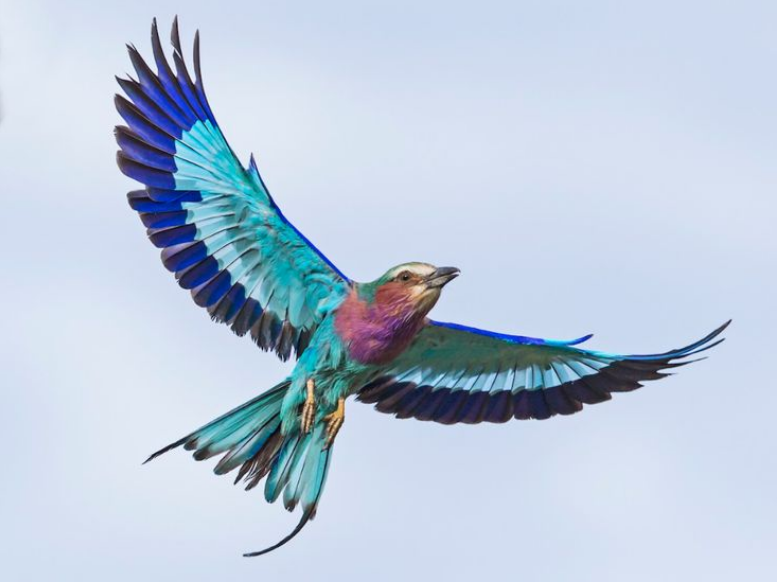
The African bush has a voice, and in Timbavati Safari Lodge, it’s often the birds who lead the chorus. Here, the days begin with the liquid notes of the Cape robin-chat and end with the haunting calls of nightjars. With over 350 recorded species in the region, Timbavati is one of South Africa’s most rewarding birdwatching destinations. Whether you’re here for the Big Five or simply to soak in nature’s rhythms, the birds offer a show that rivals any game drive.
A Seasonal Symphony: Birdlife Through the Year
Birdwatching at Timbavati is never static, it’s a living, changing performance shaped by the seasons:
- Summer (November-March): The rains transform the bush into a lush green haven, attracting migratory species from as far as Europe and Asia. Woodland kingfishers arrive in a flash of turquoise, red-chested cuckoos call from shaded thickets, and bee-eaters dart gracefully after insects.
- Autumn (April-May): Raptors dominate the skies. Bateleurs with their distinctive rocking flight and martial eagles scanning for prey are common sights. Migrants begin their long journeys back, offering fleeting glimpses before departure.
- Winter (June-August): The dry season concentrates bird activity at dwindling waterholes. Weavers build intricate nests, flocks of queleas create clouds of motion, and fish eagles call across the still air.
- Spring (September-October): The breeding season begins in earnest. Males display vibrant plumage, perform aerial courtship dances, and fill the bush with song, nature’s own festival.
For dedicated birders, timing a visit to coincide with a seasonal highlight ensures a truly unique experience.
Species You Can’t Miss
While every bird in Timbavati has its charm, a few are particularly sought after:
- Lilac-breasted roller: Often perched conspicuously, ready to launch into its famous acrobatic “rolling” flight.
- Southern ground hornbill: Endangered and striking, these long-legged birds move deliberately across the savanna in small family groups.
- Pel’s fishing owl: A rare nocturnal hunter, best spotted near rivers and waterholes in the early evening.
- Kori bustard: The heaviest flying bird in Africa, preferring open plains where it strides with stately confidence.
- African fish eagle: A symbol of African wilderness, its cry is instantly recognisable and often called the “voice of Africa.”
Each sighting is more than a tick on a list, it’s a story, a moment of connection, and an insight into the web of life here.
Guided Birdwatching Safaris: Seeing More, Learning More
Birdwatching at Timbavati isn’t just a passive activity, it’s an adventure in observation, led by guides whose skills extend far beyond mammal tracking. With decades of combined experience, they can identify a bird by a single note, mimic its call to draw it closer, or find a well-camouflaged chick tucked into a riverbank hollow.
Guests can choose from:
- Dedicated Birding Drives: Early mornings or late afternoons focused exclusively on birdlife, with stops at prime habitats.
- Walking Bird Safaris: On-foot excursions allow you to move quietly through the bush, hearing and seeing species that might be overlooked from a vehicle.
- Photography Expeditions: Tailored outings to maximise light conditions, composition opportunities, and patient observation of key species.
Bird Photography Tips from the Bush
Capturing birds in their natural habitat is as rewarding as it is challenging. A few key tips make all the difference:
- Use the Light: Early morning and golden-hour light brings out feather detail without harsh shadows.
- Long Lenses: A 300mm lens or longer keeps you close without disturbing the bird.
- Patience Pays: Wait for behaviours, preening, feeding, or taking flight, that tell a richer story than a simple portrait.
- Context Matters: Include the surrounding habitat to convey a sense of place, from mopane woodlands to riverine thickets.
Our guides understand the needs of photographers and will position you for the best possible shots while respecting the welfare of the birds.
Why Birding Matters: Conservation and Connection
Many of Timbavati’s bird species are indicators of ecosystem health. Raptors, for example, require large territories and an abundance of prey; their presence signals a thriving environment. Others, like weavers and sunbirds, are pollinators critical to plant reproduction. By appreciating and protecting the birds, we safeguard the entire ecological balance of the region.
Visitors to Timbavati directly support conservation efforts, including habitat preservation, anti-poaching patrols, and local community initiatives that promote coexistence with wildlife.
A Day in the Life of a Birdwatcher at Timbavati
Imagine waking before sunrise, stepping into the crisp morning air as the first calls echo from the trees. Your guide leads you to a quiet river bend, where a pied kingfisher hovers, then dives with a splash. In the distance, a fish eagle’s cry cuts through the dawn. By midday, you’re scanning treetops for hornbills, pausing to watch a lilac-breasted roller tumble through the air. As the day cools, you find yourself in a hide, camera ready, as a malachite kingfisher lands just metres away. And as darkness falls, the nightjars and owls take over, reminding you that birding in Timbavati is a 24-hour spectacle.
Conclusion
Birdwatching in Timbavati is not just about species counts, it’s about immersion. Every call, every flash of colour, every unexpected encounter adds to a tapestry of experiences that deepen your connection to the bush. Whether you’re here for a dedicated birding trip or simply open to noticing what the skies and trees have to offer, the lodge provides the perfect base for exploring one of Africa’s richest avian landscapes.

